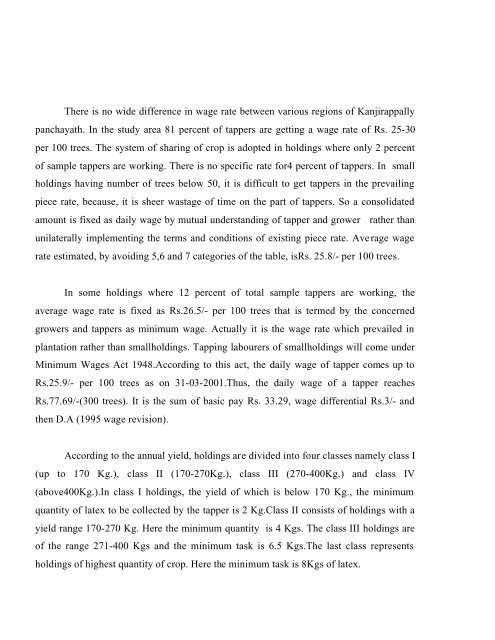socio-economic profile of rubber tappers in the small holding sector
socio-economic profile of rubber tappers in the small holding sector
socio-economic profile of rubber tappers in the small holding sector
You also want an ePaper? Increase the reach of your titles
YUMPU automatically turns print PDFs into web optimized ePapers that Google loves.
There is no wide difference <strong>in</strong> wage rate between various regions <strong>of</strong> Kanjirappally<br />
panchayath. In <strong>the</strong> study area 81 percent <strong>of</strong> <strong>tappers</strong> are gett<strong>in</strong>g a wage rate <strong>of</strong> Rs. 25-30<br />
per 100 trees. The system <strong>of</strong> shar<strong>in</strong>g <strong>of</strong> crop is adopted <strong>in</strong> hold<strong>in</strong>gs where only 2 percent<br />
<strong>of</strong> sample <strong>tappers</strong> are work<strong>in</strong>g. There is no specific rate for4 percent <strong>of</strong> <strong>tappers</strong>. In <strong>small</strong><br />
hold<strong>in</strong>gs hav<strong>in</strong>g number <strong>of</strong> trees below 50, it is difficult to get <strong>tappers</strong> <strong>in</strong> <strong>the</strong> prevail<strong>in</strong>g<br />
piece rate, because, it is sheer wastage <strong>of</strong> time on <strong>the</strong> part <strong>of</strong> <strong>tappers</strong>. So a consolidated<br />
amount is fixed as daily wage by mutual understand<strong>in</strong>g <strong>of</strong> tapper and grower ra<strong>the</strong>r than<br />
unilaterally implement<strong>in</strong>g <strong>the</strong> terms and conditions <strong>of</strong> exist<strong>in</strong>g piece rate. Average wage<br />
rate estimated, by avoid<strong>in</strong>g 5,6 and 7 categories <strong>of</strong> <strong>the</strong> table, isRs. 25.8/- per 100 trees.<br />
In some hold<strong>in</strong>gs where 12 percent <strong>of</strong> total sample <strong>tappers</strong> are work<strong>in</strong>g, <strong>the</strong><br />
average wage rate is fixed as Rs.26.5/- per 100 trees that is termed by <strong>the</strong> concerned<br />
growers and <strong>tappers</strong> as m<strong>in</strong>imum wage. Actually it is <strong>the</strong> wage rate which prevailed <strong>in</strong><br />
plantation ra<strong>the</strong>r than <strong>small</strong>hold<strong>in</strong>gs. Tapp<strong>in</strong>g labourers <strong>of</strong> <strong>small</strong>hold<strong>in</strong>gs will come under<br />
M<strong>in</strong>imum Wages Act 1948.Accord<strong>in</strong>g to this act, <strong>the</strong> daily wage <strong>of</strong> tapper comes up to<br />
Rs.25.9/- per 100 trees as on 31-03-2001.Thus, <strong>the</strong> daily wage <strong>of</strong> a tapper reaches<br />
Rs.77.69/-(300 trees). It is <strong>the</strong> sum <strong>of</strong> basic pay Rs. 33.29, wage differential Rs.3/- and<br />
<strong>the</strong>n D.A (1995 wage revision).<br />
Accord<strong>in</strong>g to <strong>the</strong> annual yield, hold<strong>in</strong>gs are divided <strong>in</strong>to four classes namely class I<br />
(up to 170 Kg.), class II (170-270Kg.), class III (270-400Kg.) and class IV<br />
(above400Kg.).In class I hold<strong>in</strong>gs, <strong>the</strong> yield <strong>of</strong> which is below 170 Kg., <strong>the</strong> m<strong>in</strong>imum<br />
quantity <strong>of</strong> latex to be collected by <strong>the</strong> tapper is 2 Kg.Class II consists <strong>of</strong> hold<strong>in</strong>gs with a<br />
yield range 170-270 Kg. Here <strong>the</strong> m<strong>in</strong>imum quantity is 4 Kgs. The class III hold<strong>in</strong>gs are<br />
<strong>of</strong> <strong>the</strong> range 271-400 Kgs and <strong>the</strong> m<strong>in</strong>imum task is 6.5 Kgs.The last class represents<br />
hold<strong>in</strong>gs <strong>of</strong> highest quantity <strong>of</strong> crop. Here <strong>the</strong> m<strong>in</strong>imum task is 8Kgs <strong>of</strong> latex.










